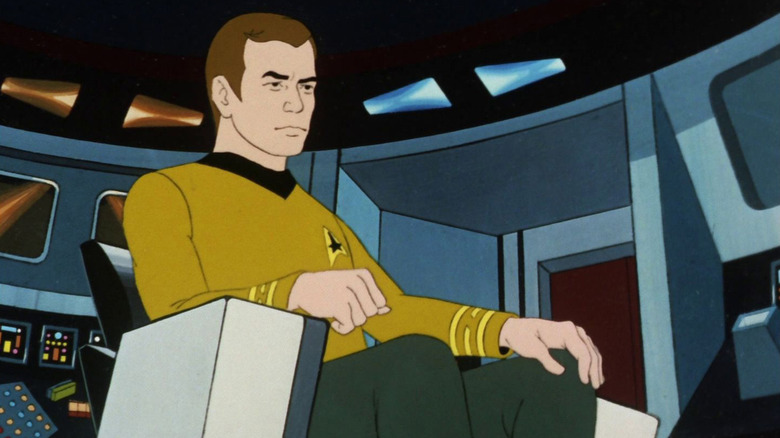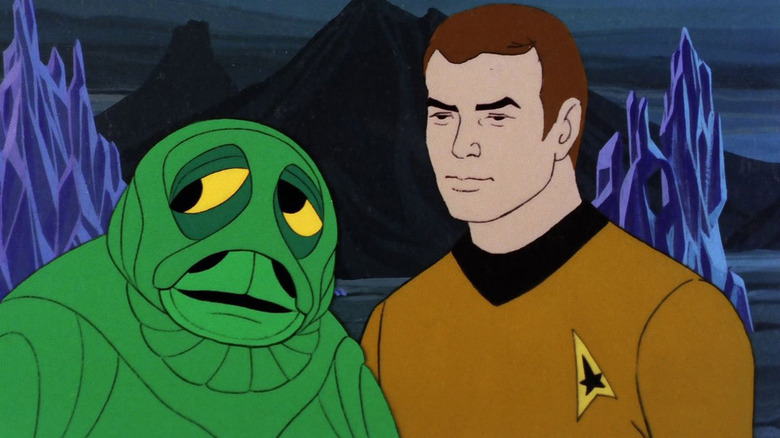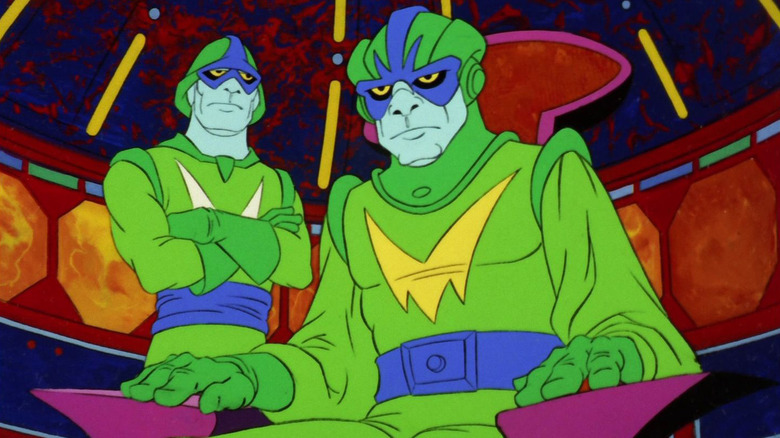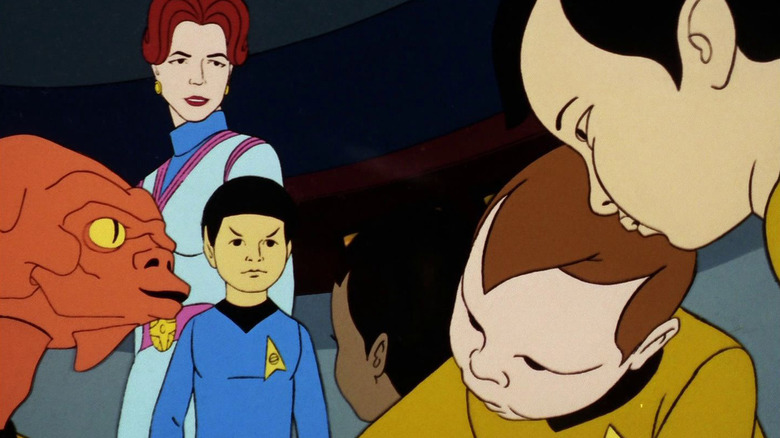5 Worst Star Trek: The Animated Series Episodes, Ranked
"Star Trek: The Animated Series" is, dare I declare, better than the original "Star Trek" that preceded it. "The Animated Series" was also created by Gene Roddenberry, starred the same cast of actors as "Star Trek" (sans Walter Koenig), and was penned by the same writing staff. The tone and the spirit of the original series remained intact, but "Animated Series" bore some distinct advantages over its forebear. For one, the series was only 30 minutes per episode, requiring the writers to be more succinct. The pacing was infinitely better as a result.
Also, the animated medium allowed the showrunners to run with wilder, more alien ideas than live-action would have ever allowed them. In animation, one can write a story about a 50-foot Spock, envision alien creatures made of plant material, or concoct an underwater civilization. Filmation oversaw "Star Trek: The Animated Series," and while the famed animation studio isn't exactly well-known for Miyazaki-level movements and visual dynamics (Filmation shows are notorious static and visually stodgy), they could at least design weird starships, animal-like aliens, and vast extraterrestrial landscapes with aplomb.
Many of the aliens, ships, and uniforms on "The Animated Series" were pink, leading to long-standing rumors that Filmation director Hal Sutherland, who was colorblind, made all the coloring decisions. In fact, most of the coloring was overseen by Irv Kaplan, who was not colorblind. He just liked the color pink.
"The Animated Series" ran from 1973 to 1974, more or less completing the promised five-year mission spoken of in Trek's original narration.
Of course, "The Animated Series" wasn't comprised of 100% bangers. Just like on the original "Star Trek," there were some pretty bad episodes as well. None of them are outright offensive, luckily, and even the bad episodes usually have some kind of ambitious idea or interesting visual twist behind them. Below are the worst episodes of the series, ranked.
5. The Jihad
"The Jihad" (January 12, 1974) is a very strange episode of "Star Trek" indeed. In it, Kirk (William Shatner) and Spock (Leonard Nimoy) are recruited into a secret mission on a distant asteroid to retrieve a mysterious artifact called the Soul of Skorr. The artifact has the memory engrams of a long-dead messiah figure etched into it, and it was recently stolen by an unknown thief. The theft has been kept secret to avoid the breakout of a holy war. Kirk and Spock are teamed with a ragtag group of aliens who will aid them in their quest. There's the birdlike alien Tchar (James Doohan), the reptilian warrior Sord (also Doohan), the feisty Valkyrie Lara (Jane Webb), and the caterpillar-like Em/3/Green (writer David Gerrold).
The sextet has to trek across a strange, brightly color landscape to a distant mountain where the Soul of Skorr is hidden, and then find a way to retrieve it from its antigravity cradle in midair. Along the way, Spock deduces that there is a saboteur in their midst, so they have to remain cautious. "The Jihad" certainly doesn't lack in intrigue, as Kirk and Spock are constantly on the lookout. It's also visually interesting, featuring some of the show's coolest aliens.
The weirdest thing about the episode is how much it feels like "He-Man and the Masters of the Universe," a Filmation production not due out for another decade. It feels like a "Dungeons & Dragons" campaign, wherein a team of writers was each invited to invent a fantasy warrior, and then throw them all haphazardly together. "Star Trek," while often stuffed with fantasy technologies, is best when its sci-fi feels reasonably grounded in real-world sciences. "The Jihad" feels like a wizard world of magical monsters. Not bad in itself, but not in the spirit of "Star Trek."
4. The Pirates of Orion
The story of "The Pirates of Orion" (September 7, 1974) is a little contrived. Spock contracts a rare illness called choriocytosis. Dr. McCoy (DeForest Kelley) can slow the progression of the disease, but Spock will die unless he gets the right kind of medicine. The medicine is on a delivery freighter on its way to the Enterprise when, as one might predict, it is attacked and plundered by Orions, a species known for their pirating tendencies. The Orions wear outlandish green uniforms and have pale blue skin. This is a contrast to the Orions on the original "Star Trek," who had forest-green skin. They also pronounce "Orion" with a stress on the first syllable, saying "OH-ree-on." The odd discrepancy wasn't addressed until an episode of "Star Trek: Lower Decks" many decades later.
Orions are supposed to be neutral in all political matters, which makes their habit of plunder a little odd. The bulk of the episode involves a tense standoff between Kirk and the Orion captain (Doohan), but it's not terribly interesting, and involves a lot of explosions. The Orions aren't a particularly compelling antagonist, and "The Pirates of Orion" doesn't delve nearly enough into their backstory or their ethos. And after the standoff, the climax isn't very tense. The Orion captain threatens to blow up Kirk, and Kirk neutralizes the bombs. The captain is apprehended and Spock is saved. No twists or revelations. The episode is merely straightforward. As a result, it's kind of dull.
3. The Counter-Clock Incident
I can name several animated shows off the top of my head that employed an "everyone turns into children" storyline. Indeed, even "Star Trek: The Next Generation" used that story in an episode called "Rascals." There seems to be something that intrigues writers about seeing their favorite characters as kiddos, and it's something I cannot personally discern. These types of stories rarely explore the childhoods of the characters in question, and often just employ an amusing visual gimmick, depicting children doing adult things. It's no more sophisticated an idea than posing kittens in "Star Trek" uniforms for a calendar. Cute, yes, but not really a story.
"The Counter-Clock Incident" (October 12, 1974) sees the U.S.S. Enterprise thrown into a parallel universe where time moves in reverse. The crew begins aging in reverse, having them become energetic adolescents and then, eventually, little kids. Luckily, the very elderly Robert April (Doohan), the first captain of the Enterprise, is on board, and he only ages into a young man, allowing him to save the day.
The physics of reversing time have never made much sense for those of us who have only ever experienced it moving in one direction, so it's best not to contemplate how one of the episode's guest characters has a son that's much older than him; maybe don't think about birth in reverse. Did their civilization begin at the point of its extinction, and then evolve backward? These are big ideas that one could have explored with "The Counter-Clock Incident," but the writers instead wrote an episode where Kirk becomes a toddler. That's not nearly as interesting. And then Robert April decided to return to his elderly state, deliberately aging back up with a modified version of the ship's transporters. I don't think anyone would want to make that choice. Be 30 again, Robert. Live longer.
2. The Practical Joker
"The Practical Joker" (September 21, 1974) is one of the most obnoxious episodes of "Star Trek: The Animated Series," and also possesses a very strange premise. The U.S.S. Enterprise passes through a mysterious energy field that somehow alters its main computer core. The computer not only becomes conscious, but gains a cruel sense of humor, playing pranks on the crew. It replaces the officers' drinkware with dribble glasses, and smears ink on Spock's observational equipment. The computer (voiced by Doohan) also replicates a uniform for Kirk that has the phrase "KIRK IS A JERK" printed on the back. It finds all these pranks incredibly amusing, but they aren't funny to us, the viewers.
The ending is at least clever: Kirk claims that he would be deathly afraid to return to the cloud where the Joker first appeared, and the computer, wanting to scare him, returns the Enterprise there deliberately. The cloud somehow sucks the personality back out.
"The Practical Joker" only needed a single hand-wavey line of dialogue to work better. Spock might have posited that the ship's new personality was extrapolated from a humor database that he had just uploaded, hoping to study Earth comedy more closely. But since no line of dialogue was written, it remains bizarre and illogical that the ship should become a giggling prankster. "The Practical Joker" is, however, notable to Trekkies as it was the first time that "Star Trek" made use of a holodeck, a technology that would become ubiquitous throughout the franchise.
1. Mudd's Passion
Harry Mudd (Roger C. Carmel) is back, this time with aphrodisiacs in his possession. Mudd had appeared on two episodes of the original "Star Trek," and earned the undying enmity of many Trekkies. Carmel gives a broad, silly performance that would have been more at home in a Mel Brooks movie than on "Star Trek," and his whimsical sexism was just proof of how little humanity had evolved by the 23rd century. Mudd previously trafficked in mail-order brides and programmable sex robots. In "Mudd's Passion" (November 19, 1973), he's hawking "love crystals," a mysterious soft ore that induces feelings of affection.
The crystals, they explain early in the episode, are 100% heterosexual. They cause one to fall in love with members of the opposite sex, and become really good chums with members of the same sex. Had the crystals been bisexual, the episode would have become far more interesting. Nurse Chapel (Majel Barrett) is abducted, and Spock snorts some crystal mess, causing him to pursue Chapel with relentless passion. He and Kirk become warm, smiling buddies. The side effect of the crystals is that they eventually fade into a temporary hatred before wearing off entirely. Everyone who was in love is now full of wrath.
Perhaps one's mileage may vary on "Mudd's Passion," depending on how they feel about Harry Mudd as a character, but for those of us who already hated Mudd going in, you won't find anything of interest. Also, in a progressive series like "Star Trek," it's disappointing to see it settle back into boring heteronormative ideas of romance. "Star Trek" can do better than a spin on "Love Potion No. 9."





